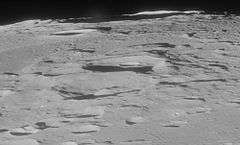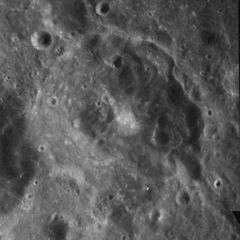Capella (crater)
|
Apollo 16 image | |
| Coordinates | 7°36′S 34°54′E / 7.6°S 34.9°ECoordinates: 7°36′S 34°54′E / 7.6°S 34.9°E |
|---|---|
| Diameter | 49 km |
| Depth | 3,5 km |
| Colongitude | 325° at sunrise |
| Eponym | Martianus Capella |

Capella is a lunar crater 49 km (30 mi) in diameter that lies to the north of the Mare Nectaris, in a rugged region with many small impact craters. It intrudes slightly into the eastern rim of the crater Isidorus, a feature only slightly smaller in diameter.
The wall of Capella is low but relatively thick and irregular, with a large promontory intruding on the south-eastern side. The crater is crossed by a deep rift, the Vallis Capella, which passes directly through Capella from the north rim through the southeast side of the wall, and extends out both sides for a combined distance of 110 kilometers. This feature was formed by a chain of craters. In the middle of the crater is a wide, round peak with a craterlet at the top. The western side of the crater is dotted with impact debris, forming clusters of small hills.
The crater was named for Marcianus Capella, a writer of Late Antiquity.
Satellite craters
By convention these features are identified on lunar maps by placing the letter on the side of the crater midpoint that is closest to Capella.
| Capella | Latitude | Longitude | Diameter |
|---|---|---|---|
| A | 7.6° S | 37.2° E | 13 km |
| B | 9.4° S | 36.8° E | 10 km |
| C | 5.7° S | 36.3° E | 11 km |
| D | 6.7° S | 37.6° E | 8 km |
| E | 7.5° S | 37.7° E | 16 km |
| F | 9.2° S | 35.4° E | 14 km |
| G | 6.8° S | 36.9° E | 12 km |
| H | 8.1° S | 37.4° E | 9 km |
| J | 9.4° S | 36.0° E | 9 km |
| M | 4.4° S | 37.0° E | 12 km |
| R | 6.0° S | 35.2° E | 7 km |
| T | 6.9° S | 34.2° E | 6 km |
External Links
- Lunar Photo of the Day, "Land of Manna", October 5, 2006, showing the region around Capella and discussing Capella Valley
References
- Andersson, L. E.; Whitaker, E. A. (1982). NASA Catalogue of Lunar Nomenclature. NASA RP-1097.
- Blue, Jennifer (July 25, 2007). "Gazetteer of Planetary Nomenclature". USGS. Retrieved 2007-08-05.
- Bussey, B.; Spudis, P. (2004). The Clementine Atlas of the Moon. New York: Cambridge University Press. ISBN 978-0-521-81528-4.
- Cocks, Elijah E.; Cocks, Josiah C. (1995). Who's Who on the Moon: A Biographical Dictionary of Lunar Nomenclature. Tudor Publishers. ISBN 978-0-936389-27-1.
- McDowell, Jonathan (July 15, 2007). "Lunar Nomenclature". Jonathan's Space Report. Retrieved 2007-10-24.
- Menzel, D. H.; Minnaert, M.; Levin, B.; Dollfus, A.; Bell, B. (1971). "Report on Lunar Nomenclature by the Working Group of Commission 17 of the IAU". Space Science Reviews. 12 (2): 136–186. Bibcode:1971SSRv...12..136M. doi:10.1007/BF00171763.
- Moore, Patrick (2001). On the Moon. Sterling Publishing Co. ISBN 978-0-304-35469-6.
- Price, Fred W. (1988). The Moon Observer's Handbook. Cambridge University Press. ISBN 978-0-521-33500-3.
- Rükl, Antonín (1990). Atlas of the Moon. Kalmbach Books. ISBN 978-0-913135-17-4.
- Webb, Rev. T. W. (1962). Celestial Objects for Common Telescopes (6th revised ed.). Dover. ISBN 978-0-486-20917-3.
- Whitaker, Ewen A. (1999). Mapping and Naming the Moon. Cambridge University Press. ISBN 978-0-521-62248-6.
- Wlasuk, Peter T. (2000). Observing the Moon. Springer. ISBN 978-1-85233-193-1.
